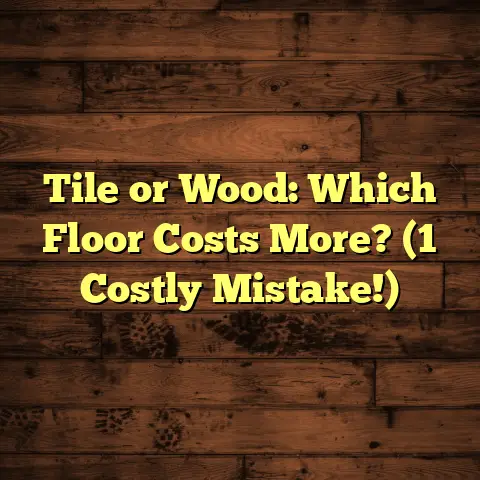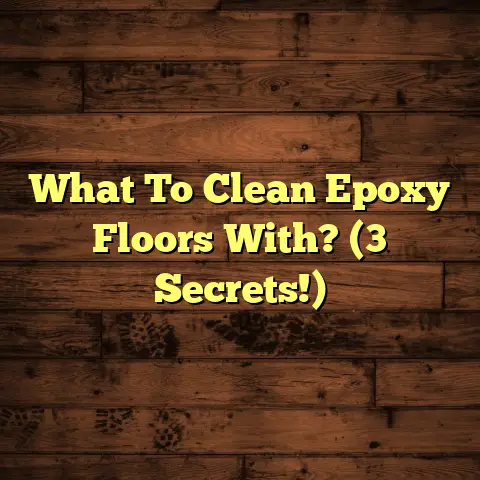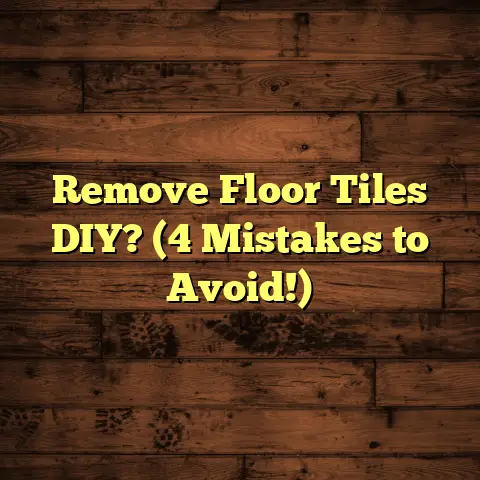Hardwood Trends: What’s Hot? (5 Styles)
In our crazy, busy lives, isn’t it amazing how much a well-designed home can impact our daily grind?
We’re constantly juggling work, family, and trying to squeeze in some “me time,” so having a space that’s both beautiful and functional is more important than ever.
And let’s be honest, flooring is a HUGE part of that.
Hardwood, in particular, strikes that perfect balance of natural beauty and long-lasting durability.
But what’s trending right now? What are the styles that are really making a splash in interior design?
Well, buckle up, because I’m about to walk you through five of the hottest hardwood trends that are transforming homes just like yours. Let’s dive in!
Section 1: Wide Plank Flooring – Embracing Space and Simplicity
1.1 The Allure of Wide Planks
Okay, let’s kick things off with a classic that’s making a huge comeback: wide plank flooring. I mean, who doesn’t love the look of those expansive, gorgeous boards underfoot?
Think about it: wide planks instantly create a sense of openness and airiness. It doesn’t matter if you’re dealing with a sprawling mansion or a cozy apartment, wide planks can make the space feel larger and more inviting.
But why are they so popular right now?
Well, wide planks actually have some historical roots. Back in the day, wider planks were more common because they were simply easier to produce with the technology available.
Now, they’re back in vogue, not just for their historical charm, but also for their modern aesthetic.
They bring a touch of rustic elegance, a sense of connection to the past, while still feeling fresh and contemporary.
1.2 Installation and Design Versatility
Now, let’s talk about getting these beauties installed. You’ve got options, my friend!
From traditional nail-down methods to more modern floating installations, there’s a way to make wide planks work in just about any space.
But here’s where it gets really fun: design combinations.
Have you ever considered a herringbone or chevron pattern with wide planks?
Trust me, it’s a showstopper!
These patterns add a touch of sophistication and visual interest, elevating the entire room.
And the best part? Wide planks are incredibly versatile.
They can complement a range of interior styles, from rustic farmhouse to sleek modern minimalism.
Want a cozy, warm vibe? Pair them with chunky knit blankets and soft lighting.
Prefer a more contemporary look? Keep the lines clean and the color palette neutral.
The possibilities are endless!
1.3 Maintenance and Durability
Alright, let’s get real: how much of a pain are wide planks to maintain?
Well, the good news is that hardwood, in general, is pretty durable.
But wide planks, because of their size, can sometimes be a bit more susceptible to warping or cupping if not properly cared for.
That’s why it’s crucial to control the humidity levels in your home.
A good humidifier or dehumidifier can be a lifesaver, especially in areas with extreme climates.
Regular cleaning is also key.
I always recommend sweeping or vacuuming regularly to remove dirt and debris that can scratch the surface.
And when it comes to cleaning products, stick to those specifically designed for hardwood floors.
But here’s the thing: the durability of hardwood makes it an ideal choice for high-traffic areas.
I’ve seen wide plank floors stand up to years of kids, pets, and countless gatherings.
With a little bit of love and care, they’ll last for generations.
Section 2: Distressed and Reclaimed Hardwood – Character and Charm
2.1 The Trend of Distressed Finishes
Next up, let’s talk about distressed and reclaimed hardwood.
This is a trend that’s all about character, warmth, and a touch of history.
What exactly is “distressed” hardwood?
Well, it’s basically hardwood that’s been intentionally aged to give it a weathered, worn look.
This can involve techniques like hand-scraping, wire-brushing, and adding dents and imperfections.
The result? A floor that looks like it’s been loved and lived on for decades.
Reclaimed wood takes this a step further.
It’s wood that’s been salvaged from old buildings, barns, and even factories.
Each plank has its own unique story to tell, its own history etched into its grain.
And let me tell you, the craftsmanship involved in creating these finishes is truly remarkable.
I’ve seen artisans spend hours meticulously hand-scraping each plank to achieve the perfect level of distress.
It’s a labor of love, and it shows in the final product.
2.2 Eco-Friendly Considerations
Now, let’s talk about something that’s near and dear to my heart: sustainability.
Reclaimed hardwood is an incredibly eco-friendly choice.
By using reclaimed wood, you’re giving a second life to materials that would otherwise end up in a landfill.
You’re reducing the demand for newly harvested timber, which helps protect our forests.
It’s a win-win!
And let’s be honest, using reclaimed wood also contributes to a truly unique home aesthetic.
No two planks are exactly alike, so you’re guaranteed a one-of-a-kind floor that nobody else will have.
It’s a conversation starter, a statement piece that reflects your values and your commitment to eco-conscious living.
2.3 Ideal Spaces for Distressed Hardwood
So, where does distressed hardwood work best in a home?
Well, I’ve seen it look amazing in a variety of spaces.
It’s perfect for creating a cozy, inviting living room, a rustic kitchen with a farmhouse feel, or even a character-filled bedroom.
Think about a living room with a reclaimed wood floor, a roaring fireplace, and comfy leather furniture.
Or a kitchen with distressed hardwood floors, exposed brick walls, and vintage-inspired appliances.
The possibilities are endless!
I’ve personally helped clients transform their spaces with distressed flooring, and the results are always stunning.
It adds a layer of depth and personality that you just can’t get with new, pristine flooring.
Section 3: Darker Tones – A Bold Statement
3.1 The Rise of Dark Hardwood
Alright, let’s switch gears and talk about something a little more dramatic: dark hardwood floors.
This is a trend that’s been gaining momentum for years, and it’s not showing any signs of slowing down.
Why are darker tones so popular?
Well, they instantly add a sense of drama, sophistication, and luxury to a space.
Think about a room with dark, rich hardwood floors, crisp white walls, and pops of vibrant color.
It’s a striking combination that’s both modern and timeless.
Darker hues can also create a sense of intimacy and warmth, making a room feel cozy and inviting.
3.2 Pairing Dark Wood with Color Schemes
But here’s the key: you have to know how to pair dark wood with the right color schemes.
Too much darkness can make a room feel small and claustrophobic.
The trick is to balance the dark floors with lighter walls, furniture, and accessories.
Think about pairing dark hardwood with soft, neutral colors like cream, beige, or light gray.
These colors will help to reflect light and brighten up the space.
Pops of color can also work wonders.
A vibrant rug, colorful artwork, or bright throw pillows can add visual interest and prevent the room from feeling too monotonous.
And don’t forget about lighting!
Proper lighting is crucial for enhancing the beauty of darker wood tones.
Natural light is always best, but if you don’t have a lot of natural light, make sure to use plenty of artificial light sources.
Recessed lighting, pendant lights, and lamps can all help to illuminate the floor and bring out its rich color.
3.3 Practical Considerations
Now, let’s talk about the practical side of things.
How do dark hardwood floors hold up in busy households?
Well, they can be a bit more challenging to maintain than lighter floors.
Darker floors tend to show dust, dirt, and scratches more easily.
That means you’ll need to sweep or vacuum regularly to keep them looking their best.
But here’s the thing: with proper care, dark hardwood floors can last for years.
A good quality finish will help to protect the wood from scratches and wear.
And regular cleaning and maintenance will keep them looking beautiful for generations.
It’s also important to consider the perception of space.
Darker floors can make a room feel smaller, so they’re not always the best choice for small spaces.
However, if you have a large room, dark floors can actually make it feel more intimate and cozy.
It’s all about finding the right balance and creating a space that feels both stylish and comfortable.
Section 4: Gray and Ash Tones – The Modern Minimalist
4.1 Embracing the Gray Trend
Okay, let’s move on to a trend that’s been dominating the design world for years: gray and ash-toned hardwood floors.
These cool, neutral colors have a contemporary appeal that’s hard to resist.
But what exactly are gray and ash tones?
Well, they’re basically variations of gray, ranging from light, almost white grays to deep, charcoal grays.
Ash tones tend to have a slightly warmer undertone, while cooler grays can feel more modern and industrial.
And the best part? These neutral colors can fit into a variety of design aesthetics.
From sleek, minimalist interiors to cozy, Scandinavian-inspired spaces, gray hardwood floors can work in just about any setting.
4.2 The Versatility of Gray Tones
The versatility of gray tones is truly remarkable.
They can seamlessly blend with different color palettes and materials.
Think about pairing gray hardwood with white walls, stainless steel appliances, and concrete accents for a modern, industrial look.
Or combine gray floors with soft, pastel colors, natural wood furniture, and cozy textiles for a Scandinavian vibe.
The possibilities are endless!
Gray flooring also strikes a beautiful balance between warmth and coolness.
Warmer grays can feel inviting and comforting, while cooler grays can create a sense of calm and serenity.
It’s all about finding the right shade of gray to create the desired atmosphere in your home.
4.3 Maintenance and Longevity
Now, let’s talk about keeping those gray floors looking their best.
The good news is that gray tones can actually be quite forgiving when it comes to dirt and wear.
They tend to hide dust and scratches better than darker floors, which makes them an ideal choice for busy families.
However, that doesn’t mean you can neglect them!
Regular sweeping or vacuuming is still essential to remove dirt and debris.
And when it comes to cleaning products, stick to those specifically designed for hardwood floors.
Avoid using harsh chemicals or abrasive cleaners, as these can damage the finish.
With proper care, gray hardwood floors can last for years.
A good quality finish will help to protect the wood from scratches and wear.
And regular maintenance will keep them looking beautiful for generations.
Section 5: Engineered Hardwood – Innovation Meets Style
5.1 Understanding Engineered Hardwood
Alright, let’s wrap things up with a look at a flooring option that’s been gaining popularity for its versatility and durability: engineered hardwood.
What exactly is engineered hardwood, and how does it differ from solid hardwood?
Well, solid hardwood is made from a single piece of wood.
Engineered hardwood, on the other hand, is made up of multiple layers of wood veneer bonded together.
The top layer is a layer of real hardwood, which gives it the same look and feel as solid hardwood.
But here’s the thing: engineered hardwood is more stable than solid hardwood.
It’s less susceptible to warping and cupping, which makes it a great choice for areas with fluctuating humidity levels.
And that’s why I often recommend it to homeowners with active lifestyles and busy families.
5.2 Design Flexibility
But don’t think that engineered hardwood is just about practicality!
It also offers a ton of design flexibility.
You can find engineered hardwood in a variety of styles, finishes, and formats.
From wide planks to narrow strips, from smooth finishes to hand-scraped textures, there’s an engineered hardwood option to suit every taste.
And the best part? Engineered hardwood can mimic the look of more expensive materials, like exotic hardwoods, while being more affordable.
That means you can get the look you want without breaking the bank.
5.3 Installation and Maintenance
Now, let’s talk about getting engineered hardwood installed.
The installation process is generally easier than installing solid hardwood.
Many engineered hardwood options are designed to be installed as a floating floor, which means they don’t need to be nailed or glued down.
This can save you time and money on installation costs.
And when it comes to maintenance, engineered hardwood is a breeze to care for.
Regular sweeping or vacuuming is all you need to keep it looking its best.
And because it’s more resistant to moisture than solid hardwood, it’s a great choice for basements and other areas that might be prone to dampness.
I’ve even recommended it for rental properties, because it can stand up to the wear and tear of tenants.
Conclusion: The Future of Hardwood Flooring
So, there you have it!
Five of the hottest hardwood trends that are transforming homes right now.
From the spacious elegance of wide planks to the character-rich charm of distressed wood, there’s a hardwood style to suit every taste and lifestyle.
And as we navigate the complexities of modern life, the trends in hardwood flooring reflect our desire for beauty, durability, and sustainability.
These trends not only enhance our living spaces but also resonate with our values and needs.
The world of hardwood flooring continues to evolve, promising innovations that will inspire homeowners to create their own unique havens amidst the busyness of life.
And I, for one, can’t wait to see what the future holds!





